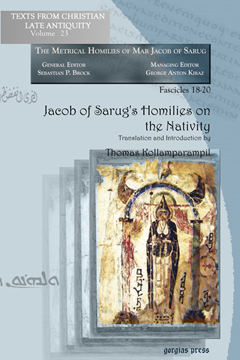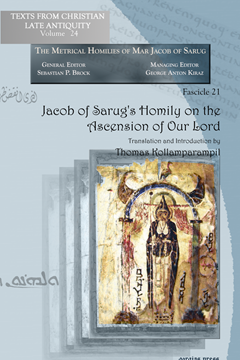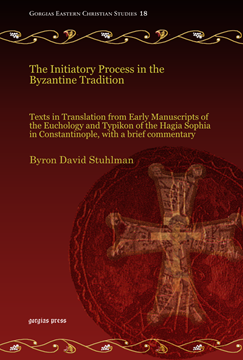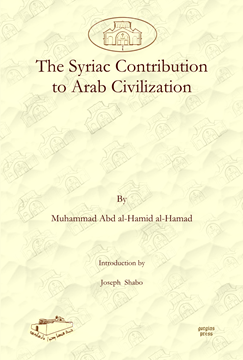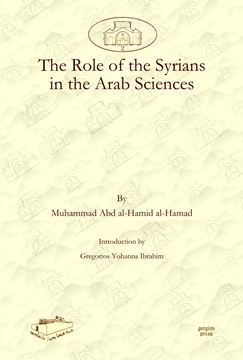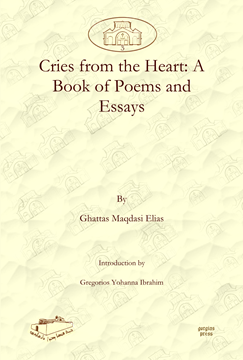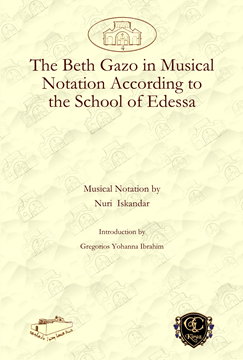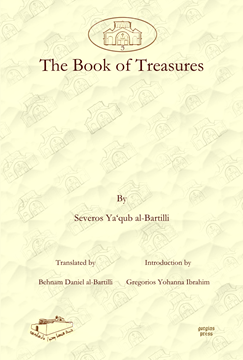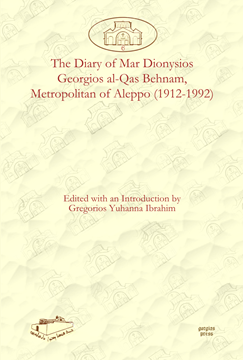Jacob of Sarug’s Homilies on the Nativity
Metrical Homilies of Mar Jacob of Sarug
Translation and Introduction by Thomas Kollamparampil
Series: Texts from Christian Late Antiquity 23
ISBN: 978-1-60724-139-3
This volume collects Mar Jacob of Sarug's (d. 521) sermons on the nativity. Always one of the highlights of the liturgical year, Jacob welcomes the Christmas season with gorgeous poetry that touches on all parts of God’s plan and the miracle of his Son being born among us. The volume constitutes a fascicle of The Metrical Homilies of Mar Jacob of Sarug, which, when complete, will contain the original Syriac text of Jacob's surviving sermons, fully vocalized, alongside an annotated English translation.
$65.00 (USD) $39.00 (USD)
Jacob of Sarug’s Homily on the Ascension of Our Lord
Metrical Homilies of Mar Jacob of Sarug
Translation and Introduction by Thomas Kollamparampil
Series: Texts from Christian Late Antiquity 24
ISBN: 978-1-60724-141-6
In Mar Jacob of Sarug's (d. 521) homily on the Ascension of our Lord, Jacob brings his understanding of the saving action of Christ to fullest poetic expression. Jacob describes how the whole of creation, starting from the beginning of history, is redeemed by Christ’s action as he reclaims his rightful place in the heavens. The volume constitutes a fascicle of The Metrical Homilies of Mar Jacob of Sarug, which, when complete, will contain the original Syriac text of Jacob's surviving sermons, fully vocalized, alongside an annotated English translation.
$34.00 (USD) $20.40 (USD)
Archaeologies of Water in the Roman Near East
63 BC – AD 636
By Zena Kamash
ISBN: 978-1-61143-421-7
Water is one of the most benign, and destructive, powers in the lives of all people, in particular in arid areas such as the Near East. This book provides an alternative way of thinking about the Roman Near East by exploring how its inhabitants managed and lived with their water supplies, especially in the wake of the Roman conquest. Through geographical, hydrological, and anthropological perspectives, this study aims to see how water can inform us about the nature of Roman Imperialism, the Roman economy, change and transformation in Late Antiquity.
$144.00 (USD) $86.40 (USD)
The Initiatory Process in the Byzantine Tradition
Texts in Translation from Early Manuscripts of the Euchology and Typikon of the Hagia Sophia in Constantinople, with a brief commentary
Series: Gorgias Eastern Christian Studies 18
ISBN: 978-1-60724-430-1
This study provides an English translation of the texts for initiation in the Byzantine tradition, drawing on early manuscripts of the euchology and the typikon of the Great Church (Hagia Sophia). This includes texts for the enrollment of children in the rites of the eighth and fortieth days, catechesis and prayers during Lent, final preparations, including consecration of Chrism and the rites of apotaxis and syntaxis on Good Friday, Baptism at the Easter Vigil, postbaptismal rites and rites of closure, and provisions for the other baptismal feasts.
$170.00 (USD) $102.00 (USD)
The Syriac Contribution to Arab Civilization
By Muhammad Abd al-Hamid al-Hamad; Introduction by Joseph Shabo
ISBN: 978-1-60724-149-2
The aim of this book is to demonstrate the movement of Greek thought into Arabic via the Syriac language. Al-Hamad devotes the four sections of this book to profiling four different authors who either wrote in Syriac or whose works were transmitted into Arabic via Syriac translations: Porphyry, John Philoponos (‘the Grammarian’), Jacob of Edessa and Dionysios of Tellmahre.
$142.00 (USD) $85.20 (USD)
The Role of the Syrians in the Arab Sciences
By Muhammad Abd al-Hamid al-Hamad; Introduction by Gregorios Yohanna Ibrahim
ISBN: 978-1-60724-150-8
This book begins with a discussion of the contribution of the areas of al-Raqqa (Kallinikos) and Diyar Mudar for translations into the Arabic language; it also covers the importance of Christian monasteries in the region of the Jazira for the history of translations into Greek.
$169.00 (USD) $101.40 (USD)
A Book of Poems and Essays
By Ghattas Maqdasi Elias; Introduction by Gregorios Yohanna Ibrahim
ISBN: 978-1-60724-151-5
This is a collection of poems and essays by Ghattas Maqdasi Elias, an important figure in twentieth-century Syrian Orthodox letters and education, also known as ‘Malfono Denho.’ The book contains writings previously published in books and journals as well as items published for the first time in this volume.
$148.00 (USD) $88.80 (USD)
The Beth Gazo in Musical Notation
According to the School of Edessa
Musical Notation by Nuri Iskandar; Introduction by Gregorios Yohanna Ibrahim
ISBN: 978-1-60724-152-2
The West Syrian Liturgy has come down to the present in three major traditions: that of Za‘faran, that of Sadad and that of Edessa. This book represents the culmination of many years of recording and effort, undertaken in both the Middle East and the US, aimed at preserving the complete Beth Gazo of Edessa in musical annotation.
$309.00 (USD) $185.40 (USD)
The Book of Treasures
By Severos Ya'qub al-Bartilli; Translated by Behnam Daniel al-Bartilli; Introduction by Gregorios Yohanna Ibrahim
ISBN: 978-1-60724-153-9
Among the works Jacob al-Bartilli has left us is this theological treatise, entitled The Book of Treasures, which has here been translated in its entirety into Arabic. The Syriac text remains unpublished and this Arabic translation has been executed by the Deacon Behnam Daniel al- Bartilli on the basis of three different manuscripts.
$182.00 (USD) $109.20 (USD)
The Diary of Mar Dionysios Georgios al-Qas Behnam, Metropolitan of Aleppo (1912-1992)
Edited with an Introduction by Gregorios Yohanna Ibrahim
ISBN: 978-1-60724-154-6
Nearly three years were spent assembling and editing this volume, which contains the diary of Mar Georgios Dionysios, the former Bishop of Aleppo. The diary covers the years 1943-1981 and offers a fascinating look at the day-to-day life of an important figure in the Syrian Orthodox Church over the course of nearly 40 years.
$242.00 (USD) $145.20 (USD)
